
Our choice: Oral-B iO6
Best overall: Oral-B iO Series 6 (iO6) / Amazon, Oral B / ~$145.17
Top of the range: Philips Sonicare DiamondClean 9900 Prestige / Amazon, Philips / ~$379.99
Best value: Oral-B iO Series 3 (iO3) / Amazon, Oral B / ~$79.97
Our verdict
The Oral-B iO Series 6 is my pick. To me, it feels like the perfect balance between features and price with no significant compromises.
After each use my teeth feel wonderfully clean and because the round brush head is smaller it is easier to move into the tightest spaces in the mouth.
You’re getting many premium features that make daily use more enjoyable. And the real-time tracking is not much worse than the 9900 Prestige which costs almost twice as much.
If you prefer to have all the features and want the absolute best, I do think the Prestige is the brush to go for. It looks and feels better in hand, you just need deep pockets.
The reality is you don’t need all the tech and extras most of these brushes offer. The iO3 cleans the teeth just as well for a lot less money. It’s the best for those on a budget and a more sensible option to buy.

Oral-B iO vs Sonicare - equivalent models
At the time of writing there are 8 different iO models and 6 DiamondClean brushes (not accounting for color variations & ‘special edition’ versions).
From a feature and price perspective, I feel the following are equivalent models.
| Oral-B | Philips Sonicare |
|---|---|
| iO Series 10 | DiamondClean Prestige 9900 |
| iO Series 9 | DiamondClean Prestige 9900 |
| iO Series 8 | DiamondClean Smart 9700 |
| iO Series 7 | DiamondClean Smart 9700 |
| iO Series 6 | DiamondClean Smart 9300 |
| iO Series 5 | DiamondClean Smart 9300 |
| iO Series 4 | DiamondClean 9000 |
| iO Series 3 | DiamondClean 9000 |
The iO Series is one range or family of toothbrushes from Oral-B. They also offer ranges such as Vitality, Pro and Genius, all of which have several models within them.
It is a similar story for Philips. ‘DiamondClean’ (non-smart) and ‘DiamondClean Smart’ are essentially 2 different ranges of brushes, but those under the ‘DiamondClean’ range have what many would consider to be smart features.
ExpertClean, ProtectiveClean, 4000 Series, 3000 Series and more are other toothbrush ranges Sonicare offer.
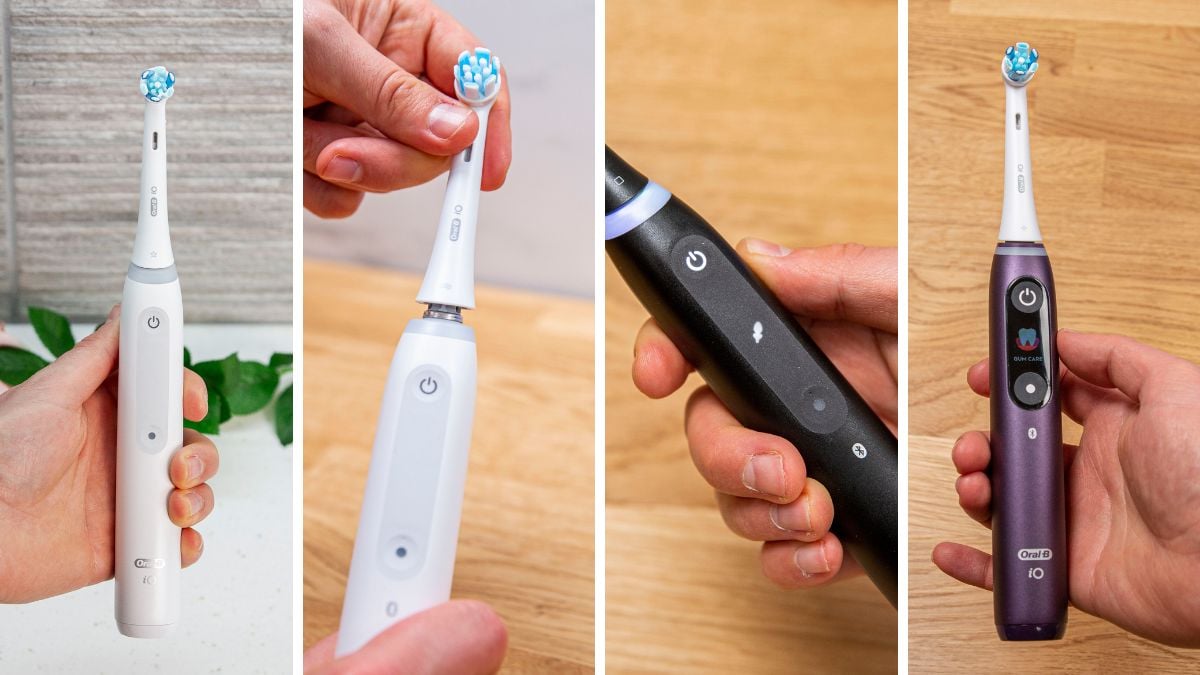
Our top iO Series picks from Oral-B
Focusing solely on the iO Series, my top 3 models to choose are:
- Best overall: iO Series 6
- Top of the range: iO Series 9
- Best value: iO Series 3
Technically, the iO Series 10 is the top of the range Oral-B model, but we do not advise buying it. We recommend the iO9 instead.
This is because the Series 10 has a much higher selling price that is very difficult to justify for the small differences between these 2 models. Our iO10 vs iO9 comparison video goes into more detail.
Our top DiamondClean picks from Sonicare
Focusing solely on the DiamondClean, my top 3 models to choose are:
- Best overall: DiamondClean Smart 9700
- Top of the range: DiamondClean Prestige 9900
- Best value: DiamondClean 9000
Do be aware Philips has manufactured many other DiamondClean and DiamondClean Smart models in the past that are no longer available.
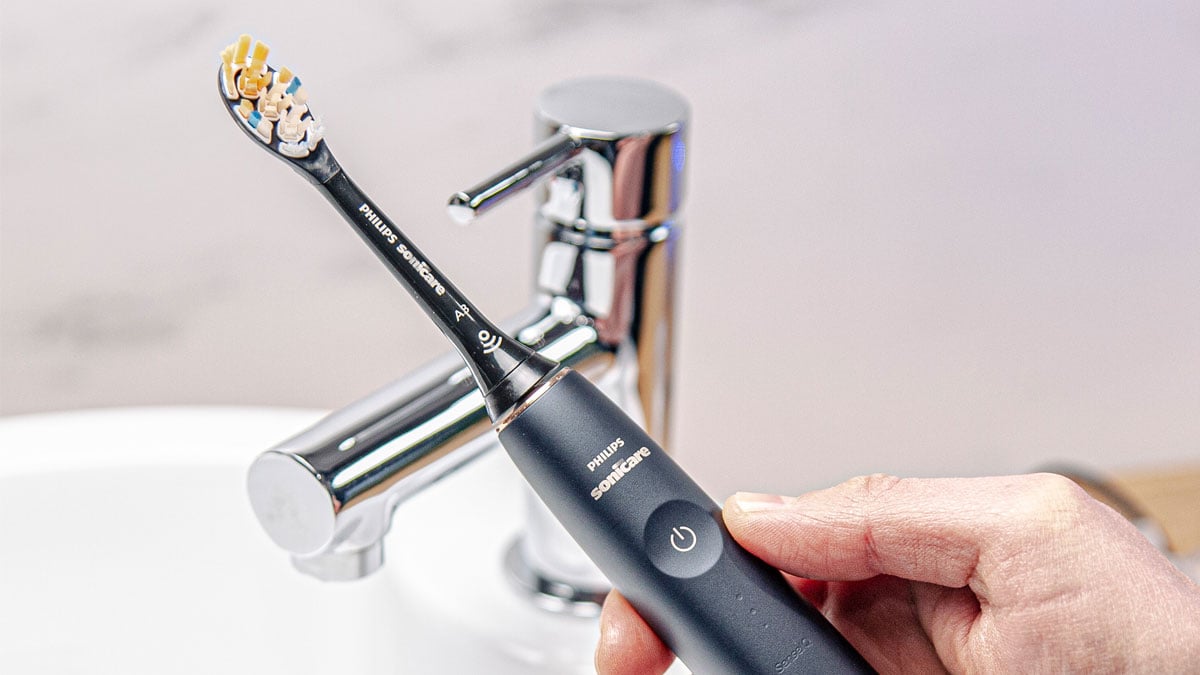
Cheaper and more affordable models clean just as well
The iO and DiamondClean brushes are more premium models from each brand. Both make cheaper brushes that clean the teeth comparably.
The Sonicare 4100 Series and the Oral-B Smart 1500 are our top picks for an electric brush from the respective brands. Both have the 3 features our dentists believe should be present in an electric toothbrush, a 2 minute timer, pacer and a pressure sensor.
The main downside of these other options is that they lack additional features that might enhance your daily usability of the brush.
You can save hundreds of dollars by opting for one of these instead.


Key differences
| Find out more |
| Electric Teeth Rating |
| Retail price |
| Approximate 3 year cost |
| Cleaning Action |
| Number of cleaning modes |
| Brushing intensities |
| Timer |
| Pacer |
| Pressure Sensor |
| Battery life |
| Battery type |
| Number of heads included |
| Travel case included |
| Bluetooth connectivity |
| Position tracking |
| Noise |
| Warranty |
| Buying options |
Please note. Every effort is made to ensure the key differences listed are correct, but these differences are subject to change without notice. Products and the box contents can be changed without notice and different variants can exist.
Detailed comparison: what’s the difference between the Oral-B iO Series and Philips Sonicare?
Design
- Sonicare brushes look and feel better
- Oral-B has improved with the iO range
- Sonicare design is more thoughtful for different users
Oral-B has come a long way in its design, ditching gloss plastics, and chunky textured surfaces to achieve a cleaner and more modern look.
Despite this, I think Sonicare models look better than the iO range.
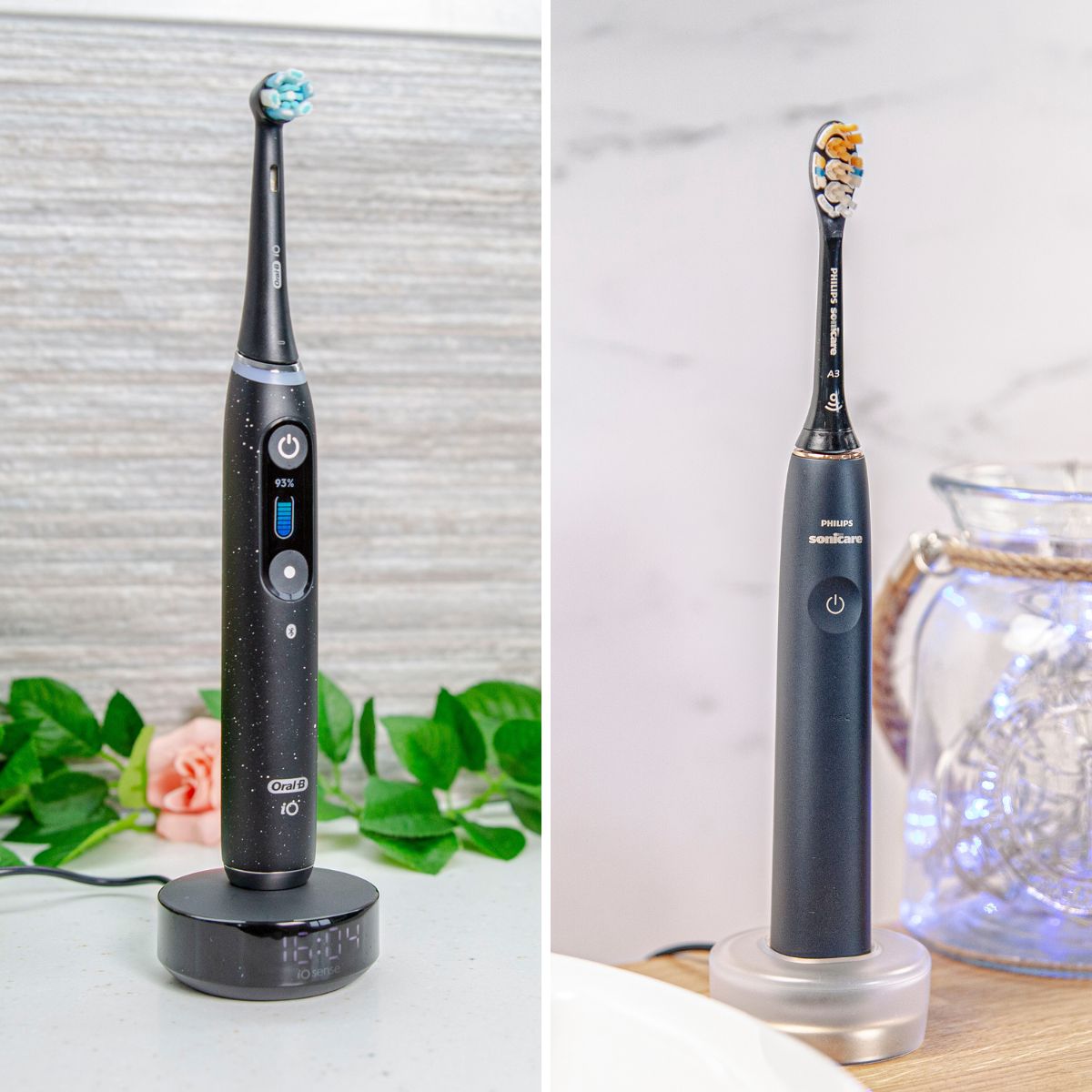
Although they are of plastic construction and not metal like SURI, the colors and matt finish to the handle look and feel classier, making them more fitting of their price tag.
All the brushes lack raised or textured surfaces for grip, but the iO in my experience still feels more slippy in the hand.
The position of the light ring for the iO’s visible pressure sensor is more logical than Sonicare’s. It is easier to see and detect than the one on the end of the Sonicare handle.
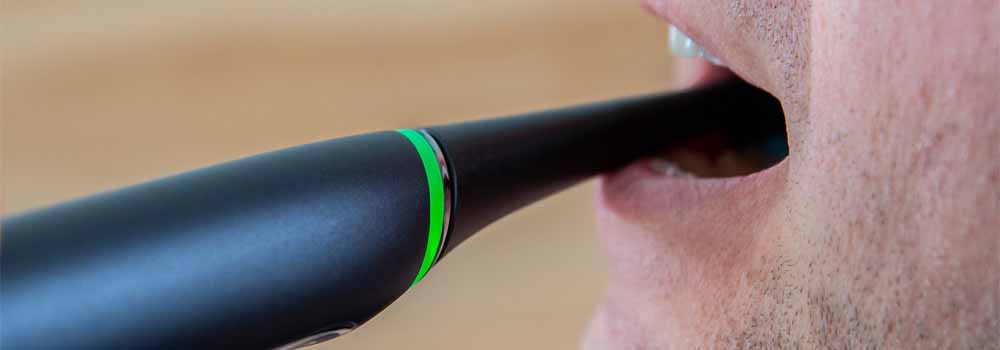
I feel Philips has considered different users' needs better. The fact the pressure sensor vibrates the handle is useful for the blind or visually impaired. Oral-B doesn’t cater to those well.
A Sonicare brush will beep and vibrate when placed on a charging stand to confirm it is on charge. It’s a small, but clever touch that just works.
This transitions to accessories too. The travel case for the DiamondClean models has far better material choices and usability than those offered by Oral-B.
I do think Sonicare has made the buttons on the Prestige more difficult to use. They require a firm press as they are pressure sensitive with no tactical feedback or clicky sound when pressed. I’ve found the buttons quite firm as an able-bodied person. Anyone with weak fingers and dexterity issues will struggle. The seamless button design was implemented to resolve reliability issues with buttons on previous models.
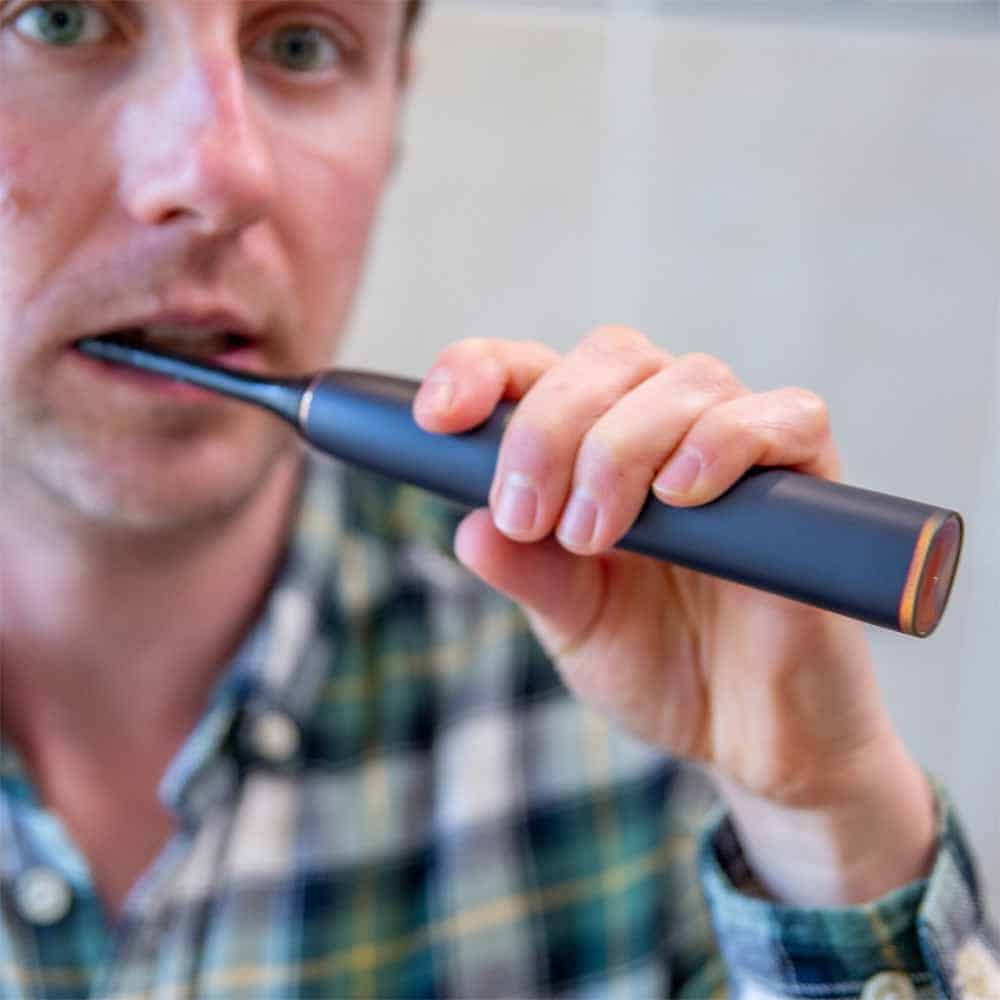
Cleaning modes
- Oral-B has most brushing modes
- Both offer the preferred modes you want
Oral-B takes the crown with 7 brushing modes on the iO9 and 10 compared to the 4 or 5 on the DiamondClean models.
| Number of cleaning modes |
| Clean |
| Sensitive |
| Gum |
| White |
| Deep Clean |
| Tongue |
| Other modes |
| Cleaning mode notification |
| Brushing intensities |
| Cleaning Modes Additional Information |
In all my years of testing and writing about electric toothbrushes, I’ve yet to see any compelling evidence for all the extra modes. None are going to radically change the cleaning results.
I’ve yet to meet anyone who regularly switches between any more than 2 modes.
A standard clean and gentle mode (Sensitive or gum care) is enough. These cater for most users, including new electric brush owners who might find the brushing power a bit strong. All the models have these.
Changing between modes is a bit easier on the DiamondClean models, for the most part. They have a dedicated mode button and clear backlit text labels to show which modes are active. This doesn’t apply to all the iO models. Some have none at all, others icons and the more expensive models displays, which are far more functional.
The Prestige makes changing brushing modes most difficult. You have to access the app to change the mode and confirm which one is active. It’s frustrating, but oddly not a big issue given most, myself included rarely change between them.
In the mouth, the brushing sensation does differ. DiamondClean models feel more gentle, but the sonic vibrations can be a bit ticklish on the teeth and gums.
Oral-B’s cleaning action is more intense, a deeper sensation that I prefer, but it might feel a little harsher to some.
If you have gum recession or gum disease Sonicare is the better choice.
Bluetooth and technology, including real-time tracking
- iO’s tracking is better on the most premium models
- Sonicare doesn’t track your biting surfaces
- All give a good insight into your oral care habits
All brushes, bar the iO3 have Bluetooth connectivity.
The iO4 and DiamondClean 9000 do connect to phones via their respective apps, but neither offer real-time tracking. They won’t show you areas of the mouth you have and have not brushed. They log how often you brush, how long and extra stuff such as if you flossed etc.
All the other handles can track in real-time. This means you can take corrective action immediately to finish your brushing session with the best brushing results and coverage score possible.
- The iO5, 6, 7 and 8 tracks 6 zones of the mouth.
- The Prestige 9900 and DiamondClean Smart models track 12.
- The iO9 and Series 10 track 16.
| Bluetooth connectivity |
| Position tracking |
| Smart Features Additional information |
You do gain a bit more insight from the iO9 and 10, but it isn’t necessarily significant.
It is easier to tell you might not have brushed the biting surfaces of the back right teeth than you can on the Prestige for example. Sonicare models don’t count the biting surface as a zone oddly.
I test brushes for a living and I don’t use these features regularly. I know some do, but the vast majority only use them periodically or stop after a while.
It is useful data they all offer, but they can be a bit of a faff, as to make the best use of them, you need your phone which you when you brush, which isn’t always desired or convenient.
You need to be committed to getting maximum benefit from the tech.
Although the iO4 and DiamondClean 9000 don’t track zones, they do still build up a bit of a picture of your routine and allow you to glean some insights and find areas for improvement.
The Prestige 9900 and DiamondClean Smart have scrubbing sensors. This is an alert system that makes you aware if you are moving the brush too much and not achieving the correct technique.
The 9000 and 9700 have brush head mode pairing. This is where the brush automatically changes the brushing mode based on what style of head is attached. It saves 1 or 2 button presses each time you use a different head if you like to switch modes at the same time. I’d never suggest picking a brush for this feature alone.
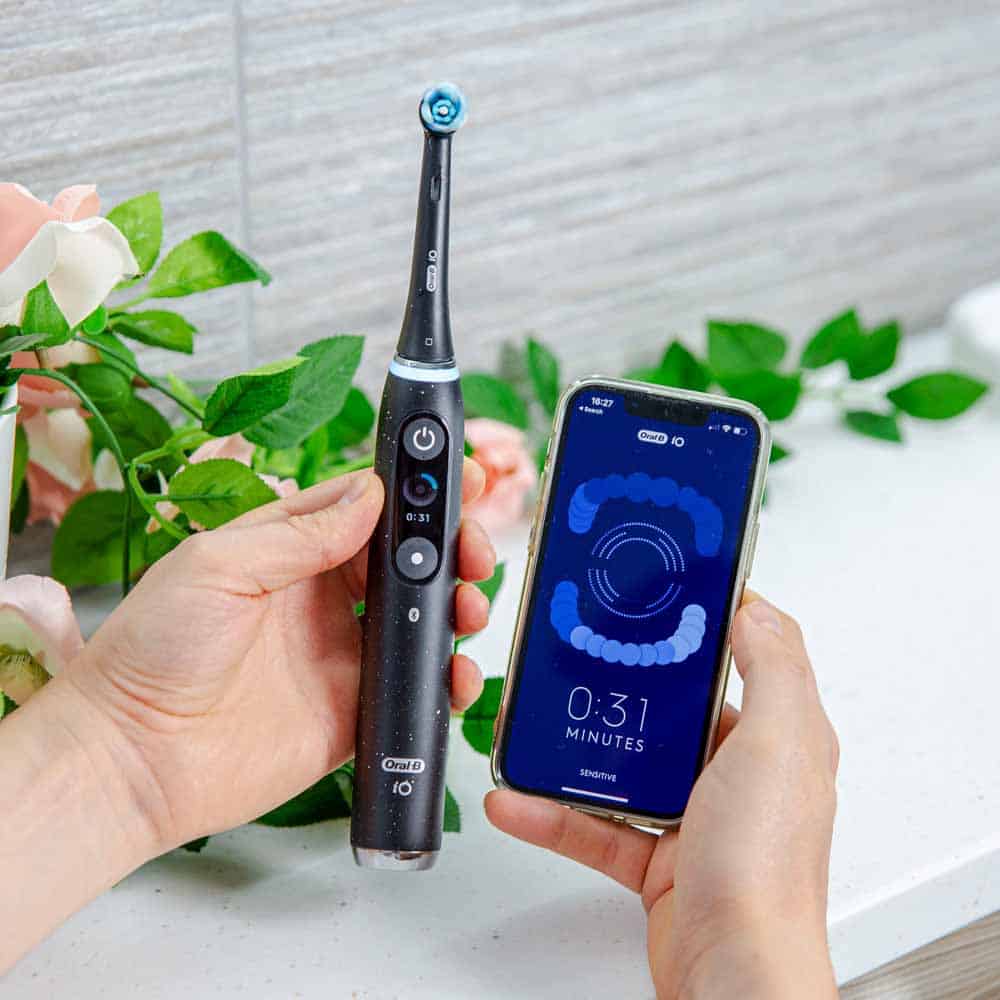
Travel cases
- Sonicare’s cases are better
- USB charging rather than Oral-B’s clunky proprietary charger
There is no question that Philips has nailed the travel cases compared to Oral-B.
| Travel case included |
| Charging travel case |
| Brush head storage |
| Travel case Additional information |
The 9900 Prestige travel case is one of the most compact and travel friendly options I have ever used. The built-in USB Type-C port allows the brush to be charged whilst inside, which is useful.
Oral-B’s iO9 and 10 which come with charging cases rely on bulky, proprietary power adapters which make for a more cumbersome accessory when on the go.
The DiamondClean Smart 9700 and 9000 also offer in the case charging, with a hardwired USB cable built in.
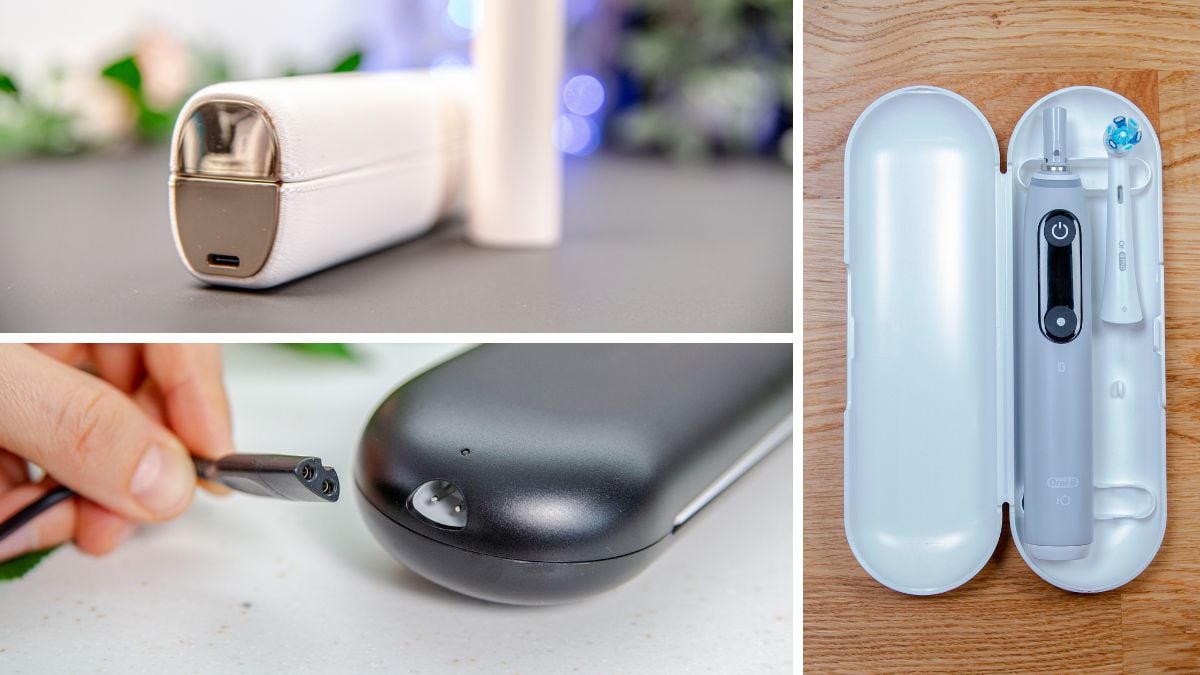
Battery and charging
- Both have a claimed 2 week battery life
- Sonicare far outperforms the claimed life where Oral-B struggles
- Some Oral-B models can charge faster
- Sonicare support a wider voltage range - better for travelers
Looking at the specifications alone, the brushes are comparable. All use rechargeable Lithium-Ion batteries, which are said to offer around 2 weeks of use on a full charge.
However, specifications and reality differ quite considerably.
As a general rule, the Sonicare models perform far better, giving 1 or more weeks of extra use. Whereas the iO7, 8, 9 and 10 can struggle to regularly achieve 2 weeks.
Their displays seem to activate when they shouldn’t causing unnecessary drain on the battery. I’ve quite often been surprised my iO has needed charging at times when I didn’t think it would.
| Battery life |
| Hands-on battery life |
| Battery notification |
| Charging time |
| Voltage support |
| Charging stand connector |
Oral-B does offer quicker charging times, of up to 3 hours on some iO models. This might be good if you need to get a quick charge of your brush, but it’s certainly not a reason to opt for iO over Sonicare.
Sonicare charging stands tend to have support for 110-220v making them more convenient for travel, whereas only a select number of Oral-B’s stands support this voltage range. Most are limited to 110-130v, meaning adapters are required when using overseas.
It’s worth noting that neither brand's batteries are designed to be replaced.
Everything else
I’d hate to bore you with every last detailed difference between models, but there are some key extra things you should know.
Automatic power off
Sonicare brushes power off automatically after their brushing cycle. If you want to brush for longer you need to press the power button to turn it on again. Whereas Oral-B brushes keep running until you turn them off.
I like how obvious Sonicare makes it that the brushing cycle is complete. But, it’s your personal preference as to which you prefer.
Noise
Most Oral-B models don’t operate past 64dB, but I’ve found the iO 7, 8 and 9 do peak at over 70 decibels.
Most of the DiamondCleans are no louder than about 71dB, but it can depend on the mode and intensity chosen. Often they are far quieter.
Sonicare models have a less mechanical noise and pitch whereas Sonicare is more of a subtle audible hum.
Size and weight
There isn't a lot between them. Tenths of inches and a few ounces subject to which model you are comparing.
| Toothbrush height with head |
| Width |
| Depth/thickness |
| Weight with head |
Keeping them clean
Sonicare models are easier to keep clean.
It’s fairly easy to wipe off grime and debris that builds up on the head and handles, but the iO has a brush head design and attachment which can result in a buildup of mold. This isn’t something experienced on Sonicare models.
Our video shows the bacteria growth inside an Oral-B head, if not cleaned properly.
Warranty
Both brands offer a 2 year warranty as standard.
Accreditations
Many Oral-B brushes have been tested and approved by the likes of the American Dental Association.
Being approved does give an extra level of confidence that brushes perform to a certain standard. However, the brands do have to pay for these, so the cynic would argue Oral-B have paid for that extra vote of confidence in their products.
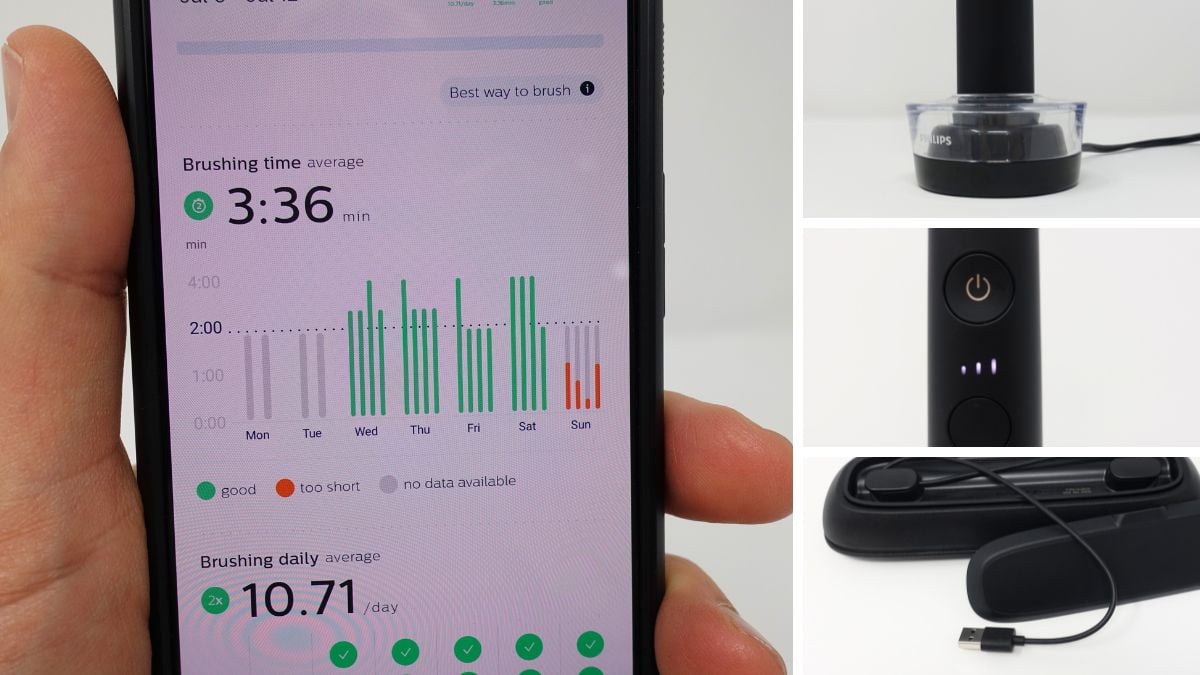
Does one clean better than the other?
The short answer is no.
From my time using them, I prefer Oral-B’s cleaning action. It feels more intense and like it’s cleaning deeper. But my plaque disclosing results haven’t shown any reason to suggest the DiamondClean brushes clean worse.
If you brush twice a day, for 2 minutes each time, with the correct technique, then the reality is that all models from either brand are going to achieve comparable results.
Your dentist wouldn’t be able to tell you were using one brand or model over another.
Therefore it’s not worth worrying about. Your brushing time, frequency and technique have a far bigger impact on your dental health. You could have the ‘best’ toothbrush, but unless you use it correctly you’re not going to benefit.
But, this study, would suggest the iO Series removed up to 48% more plaque at the gumline and 62% more effective at reducing gum problems. Make up your own mind as to whether there might be some bias, given the research was funded by Oral-B’s parent company Procter and Gamble
The way the bristles move is different. The iO bristles have an oscillating, rotating and vibrating cleaning action compared to the back and forth bristle movements of Sonicare.
Clinical studies such as this one suggest a marked difference in the clean offered by the oscillating rotating brush compared to the sonic option.
On the other hand, a 2019 study in the Journal of Clinical Dentistry (page A9) funded by Philips Oral Healthcare shows their sonic toothbrush outperforms the oscillating-rotating Oral-B.
An independent review of existing studies found that there is some evidence that Oral-B brushes are better at cleaning. However, the difference is small and the clinical significance of this is unclear.
Thus, reconfirming that one doesn’t clean better than the other.
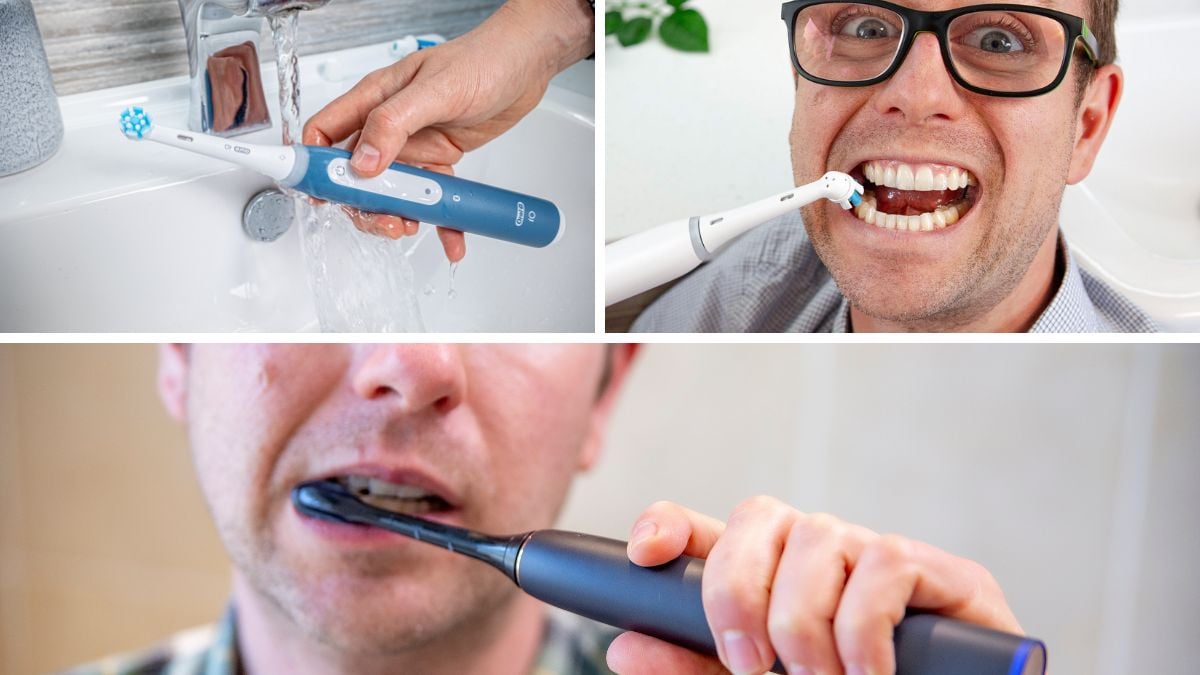
Complicating matters further, the real-time tracking that is available on some of these might allow better cleaning results to be achieved, from one model vs another.
Specific models such as the DiamondClean 9000 track and log some of your brushing habits, but it does not track and display your brushing in real-time. It won’t show you areas of the mouth and teeth you haven’t brushed, whereas the others do.
Those that do can help you learn to improve your brushing technique. In turn, you will get better results long term. But, this data is making you a better brusher. The brush itself is not cleaning the teeth any better.
In reality, it is a lot of effort for very little gain. I’ve got all these models and more. Do I use the tracking data and log into the app regularly - no, I don’t.
People who have bought these models and similar ones have said the same thing to me.
This tech isn’t necessarily a waste, but there is no point paying for and having it unless you will use it.
Is one better priced than the other?
Yes.
As a general rule, the Oral-B brushes are better value and cheaper to own. But, it does depend on the model you are looking at or comparing.
The iO3 has a retail price of $80 compared to the $200 of the DiamondClean 9000.
However, at the top of the range, the Oral-B iO10 is $400 like the Prestige 9900.
| Retail price |
| Typical selling price |
| Approximate 3 year cost |
Conclusion
The iO3 from Oral-B is the best value purchase. It gives you all the essentials you need. It cleans the teeth well and is the brush I would recommend to my friends and family if they wanted one from the iO Series.
It’s the Prestige I would recommend to anyone who isn’t price sensitive and wants ‘the best’ because they can, providing they know it isn’t going to clean their teeth better than other options.
If you want the best of both worlds then the iO6 is the brush to go for. The display creates a more interactive and useful way to change cleaning modes and see how much time remains as you brush. It gives enough information on your brushing habits that you can make positive changes. Most importantly, it doesn’t cost too much.







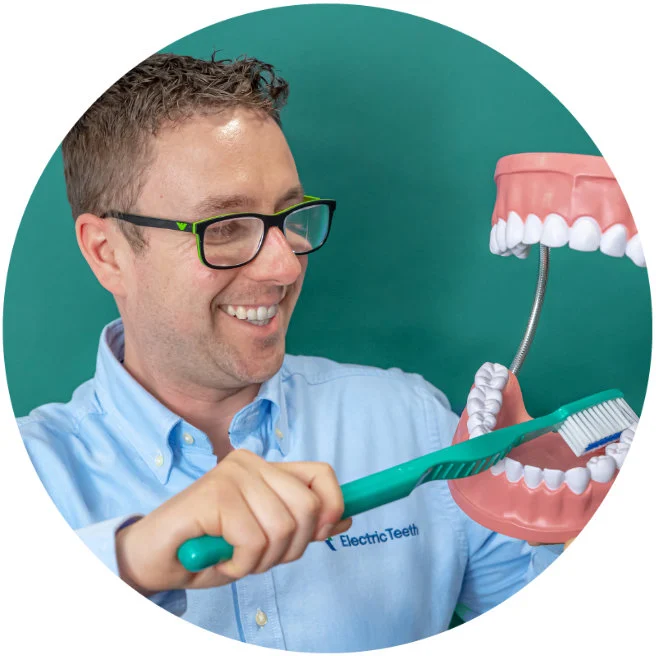
Ciao, quali dei due spazzolini è più indicato per gengiviti? Comprendo che tutti e 2 hanno programmi di spazzola mento delicato e di indicatori di pressione….ma quali dei due è migliore in questo campo ?
Hi Bruno. Great question.
Honestly, both are comparable and there is no solid evidence to say 1 is necessarily better than the other.
What clinical evidence that is available would suggest Oral-B cleans better overall.
Ciao Bruno. Ottima domanda.
Onestamente, entrambi sono comparabili e non ci sono prove concrete per dire che uno sia necessariamente migliore dell'altro.
Quali prove cliniche disponibili suggerirebbero che Oral-B pulisce meglio in generale.
One major advantage for me is that the Sonicare brush heads are available from many 3rd party sellers,for much cheaper than the Oral B iO heads,which at this time,are only available from the manufacturer.In fact,at our local swap meet(AKA flea market) there are a lot of Amazon return items,including unused 3rd party Sonicare compatible heads for about .10 each.
Thanks for all the videos and documents. I'd be interested in hearing your thoughts on which of these toothbrushes or similar models (I'm thinking of the iO 7 in particular) is most convenient for travel. The io 7 is of interest because it appears to come with a cloth pouch rather than a hard (and bulky) case, which I suspect takes up less space in one's toiletry kit. On the other hand, I think one would need to bring the bulkier charger ... is that right? I also think the iO 7's app only gives data on 6 regions, while the iO9's app gives data on 16. Is all this correct?
Any additional thoughts about which is best for travel? Are the hard cases for the DCS and iO9 comparable in size?
Thanks.
Hi Peter.
Some good questions here and really digging into the finer details.
In principle, the soft pouch case of the Series 7G variant could be argued to take up less space, but it doesn't give quite the same level of protection, particularly if you were to place the brush head inside this pouch. The 7G does come with a storage case/cover for the brush head that offers more protection.
There is a 7 series variant that comes with a hard case, which I think would take up a similar amount of space to the pouch & brush head case of the 7G variant. With the 7 series you would need to take the charger with you, if you are travelling for more than 14 days (the battery life of the iO).
Compared to the iO9 with the charging case, I think ultimately there isn't much in it, because you have to take the power cable for the charging case which is similar in capacity/size to the charging stand for the iO9. Albeit I think the iO9 solution is fractionally more practical when traveling.
It is correct that the iO9's tracking is a little more thorough. I don't feel it is a deal-breaker though. The fundamental principles are upheld by the Series 7 and its app configuration.
The hard case of the iO9 and DCS are comparable in size. I haven't and don't intend to do the maths to say 100%.
It is ultimately personal opinion. My preference for travel is the DCS, the case feels more logical and practical for frequent travelers.
I used to Oral-b for about 10 years, and it was very durable. However, I was always curious about the overwhelmingly positive reviews for Sonicare. So, moving on, I purchased the Sonicare DiamondClean in 2019. It lasted just one year before the motor stopped transferring power to the brush head. It was under warranty, so Phillips replaced it. Then, like clockwork, the warranty replacement did the same thing a year after that.
Kindly, Phillips replaced the second handle, even though it was just out of warranty, although they tried to sell me an extended warranty. I declined.
I am waiting for my replacement DiamondClean. However, I have to say that I'm done with Sonicare. People talk about the quality. They say it's say it's just so wonderful, but I'm here to tell you that it's poorly made and not durable.
So, I just ordered the Oral-b io9, which I got on sale for being a member at Bed bath and beyond. Otherwise you have to cough up the 300. I spent 240.
In fact, it is due to arrive today. I'm free from Sonicare! I'm going to give away the Sonicare handle to family. I'm very glad to be back with Oral-b.